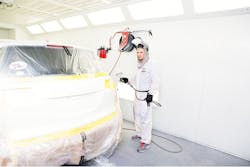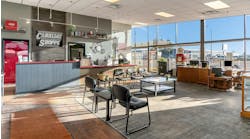SHOP STATS: Dalton CARSTAR South Location: Dalton, Ga. Operator: James White Staff Size: 34 Average Monthly Car Count: 100 Annual Revenue: $5 million
Chris Williams began his career in the industry at 14 years old. He started working as a shop helper at one of Ken’s CARSTAR shops in Dalton, Ga., but quickly moved up to an apprentice position in the paint department. All the while, he balanced being a high school student at Whitfield County Career Academy in Georgia and working a job.
As a student at Whitfield County Career Academy learning about automotive technology, Williams had this desire to push himself to learn more about collision repair. This desire for knowledge led him to compete in the automotive refinishing technology category of the 2011 SkillsUSA competition, held in Kansas City, Mo. He was the third-place finisher in this national competition.
Fast forward to Williams at age 25, and he’s now the lead senior painter at Dalton CARSTAR South, where he’s made a widespread impact.
“He is the leader in the paint department, he averages 150 percent efficiency,” shop owner Jamie White says. “Any questions that someone has in regard to a vehicle going through the paint process, he is the guy that has all the answers.”
I started out from the bottom of the totem pole, like most people. But, I’ve always had an inkling for tinkering with anything that has wheels.
When I started working at the shop, I was fascinated by the idea of reversing the effect of a collision. I helped the main techs in the shop, but I wanted to learn how to do what they were doing. I was the gofer—the person who helps with everything, the guy who catches everything. If someone needed a hand, I would help them out.
Then I migrated to the paint department, where I worked as a helper for the lead painter. Two years later, Ken’s CARSTAR branched out to the Dalton location and Jamie asked me to be the lead painter there. When he asked me to be the lead painter, I feel like it came upon me quick. I didn’t see myself as good as my boss thought. Here I am four years later, though. Time just flies by.
Usually, we have our morning meetings at 8 a.m. We talk about what needs to get done in the day. During our morning meeting, service advisors will come through and I’ll check in with them and let them know how things are going.
After our morning meeting, my helper, Justin, pulls the vehicle we need to get painted first thing in the morning and starts the prep work. He’s been working here at the shop for 7-8 months now. We actually graduated together and after my former helper moved to Tennessee, I reached out and asked him if he was interested in the job. He’s not very familiar with the industry, so I’m teaching him everything I can.
While he’s pulling the car for me, I work on matching colors and getting sealers ready. I use the computer to help with that. I enter the paint code into the database and it pulls up the colors I need. If I can’t get any good color chips, I start doing sprayouts. Doing sprayouts helps me see how much I need to adjust a color, so that it matches the original paint of the vehicle. I will do sprayouts until I get an acceptable color match.
I also look over the repair order and make sure everything is there. I look through my section and make sure that everything listed as needing a coat of paint is painted.
Before I paint the vehicle, I double check the repair quality. We try to cover each other’s bases, so I make sure I do my part and assess the work already done before I paint. With looking over the repair, I make sure it is acceptable for an insurance company to clear.
We then tape up the car and clean it. I go in and seal, if I need to do so. I add the basecoat to the car and clear it. Then I bake it. Then we move on to the next vehicle.
This is all part of the production process. The more vehicles you complete, the better. From time to time, I might have to sand out a run in the clear. Most of the time, though, the paint jobs that come to me aren’t full-body paint jobs. Sometimes I have to do just panels or doors.
Usually, total prep time between paint jobs, when it’s not the whole vehicle, is 20-30 minutes. Unless you are having problems color matching, then it might go on a little longer. From start to finish, the paint process, when we have to paint a whole car, takes about 8 hours. I can spray 4-6 vehicles in a day, depending on the size of the car and weather. If it’s humid outside or rainy, the paint will dry much slower.
I talk to the service advisor roughly 4-5 times per day. They come through and check to see if we have any trouble. Sometimes we get calls to get high-priority vehicles done first, so my helper and I shift gears to accommodate.
During times where we have bad weather, like hail storms, the shop gets packed so we have to make sure we are as efficient as possible. I know the customer’s need for his or her vehicle. Our focus is always on speed and quality.
My favorite part in the process is when I put my clear on. Each time, you can kind of critique yourself to do better and it’s the most challenging part. The paint job is like the icing on the cake. That’s what customers really look at.
Sometimes, I like to do a tape-off with Justin. We like to see who can finish taping their side of the car first. I also like spot repairs. You know, each car has its own texture, and I try to match that texture, so no one will notice the difference between the original paint and what I did.
I see a vehicle as my canvas. What’s neat to me is that everybody gets to look at my work. I can put a little bit of pride into it because it’s something that I’ve done. And, I also enjoy the challenge of color matching.
If the paint job isn’t done correctly, then the car isn’t going to its owner. My role has drastically increased. Paint jobs, I would say, are the most important roles in the shop.
I’ve taken I-CAR, pressure sensitive paint (PSP)/PS2 training and BASF classes to help me stay up to date, paint wise. I didn’t go to college, so what I’ve learned is from on-the-job training or these courses.
I’m a patient person. My helper is still learning things about the industry and all the components of the paint process, so I try to show him what I do and the most efficient way to do things when I was in his shoes. I see a little bit of me in him. I always tell him if you can find a faster way to do a certain task, that’s your call. I’ll show you my way, but you can do it your way as long as it’s right.
I don’t get worked up easily over anything. I try to show things in repetitive steps and I give him time to ask me questions. I explain the processes the best way I can.
In this line of work, every detail counts. I was always told, if you mess it up, you can always fix it. But you always have to have a little bit of confidence in yourself and your work.
Above all, don’t give up right off the bat. Painting cars isn’t something that you can do overnight. It takes practice. Each time you do it, try to learn from the mistakes you make. Make each time better.



